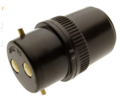I had a similar question recently where two RFC’s would be protected by the same MCB and some on this group suggested that was not allowed and also, it would cause problems with the test sheet. ....
They did but, although it would be a pretty strange and confusing thing to do, as I said at the time ...
(a) I can't think of anything in BS7671 which 'disallows' it, and ...
(b) The issue with the 'test sheet' is pretty trivial, and can be remedied by completing two rows, one for each ring, for one MCB
The same people would probably (hopefully!) have no problem with one or more 'spurs' from the ring (essentially 'radials') originating from the MCB protecting the ring, so why should it be different if the extra bit(s) originating from the MCB is another ring?
I'm not saying that I would 'do it', but that's not the point!
.... Is the lighting situation not affected by the same concerns?
I suppose you would have to ask 'them' about 'their concerns'

. However, I doubt that they would have a problem with that, since there's nothing wrong with having two branches of a radial originating from the MCB. After all, if there were a single cable coming from the MCB (i.e. 'a radial') which, after 6 inches or so, split into two branches (which is virtually the same as 'splitting at the MCB'), then I don't think anyone would have any problem with that - and lighting circuit radials often 'branch' all over the place.
As I implied before, in some senses this is semantic since, by BS7671 definition,
everything protected by one MCB is "a
[i.e. 'one'] circuit", no matter how many conductors are connected to the MCB - so, as far as BS7671 is concerned, you
cannot have more than one circuit protected by one MCB!.
All that matters to BS7671 is that each and every cable connected to an MCB is adequately protected by that MCB, regardless of whether the cable is 'a radial', 'a branch of a radial', 'one end of a ring' or 'a spur from a ring' (the last being no different from a radial).
That's how I see it, anyway!
Kind Regards, John


